For those of us who already live in Spain, you will know the Spanish love a good party. And, let´s face it – there ARE plenty of fiestas and celebrations.
However, for those perhaps planning a trip to Spain this year, InSpain.news has put together a list of fiestas and dates for your diary that you might want to coincide with a visit.
These events and fiestas are annual, but please check up-to-date information on any event as there could be restrictions or postponements due to Covid-19 measures.
Furthermore, the list of ferias, fiestas, celebrations, and holidays in Spain is endless. However, we hope you enjoy the ones we have chosen.
January
Wednesday 5th
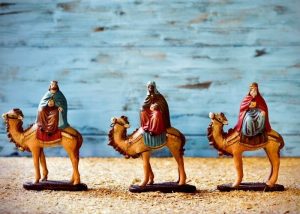 The three Kings Parade or “Cabalgata de Los Reyes Magos” in Spanish and “Cavalcada del Reis Mags” in Catalan, is held on the evening of the 5th of January each year. Every town and city will have a procession* with the Three Kings as protagonists where sweets are thrown from the floats to the children. Moreover, it is a wonderful family evening out.
The three Kings Parade or “Cabalgata de Los Reyes Magos” in Spanish and “Cavalcada del Reis Mags” in Catalan, is held on the evening of the 5th of January each year. Every town and city will have a procession* with the Three Kings as protagonists where sweets are thrown from the floats to the children. Moreover, it is a wonderful family evening out.
Then, if you have not already done so, you can buy a Roscón from any bread or cake shop.
Some children may leave a clean pair of shoes by the door with a note inside and some straw. And at night, when the children go to bed, the three kings with their camels visit and leave gifts to be received in the morning.
Thursday 6th
Three Kings Day marks the day in which the three kings would have arrived to visit baby Jesus. In many Spanish families, this is the main gift-giving holiday.
Thursday 20th
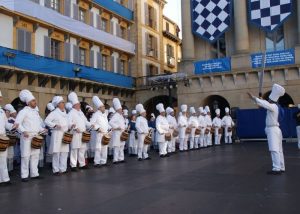
La Tamborrada of Donostia is a celebratory (and loud) drum festival held each year from midnight on January 20 in the city of San Sebastián. Rain, hail or shine, thousands pack Constitution Square when the mayor raises the San Sebastián flag at midnight for the 24 hours of non-stop drumming to begin.
February
The Almond Festival La Palma – Normally, each year at the beginning of February when the almonds are plentiful, the locals on the island of La Palma gather around the market squares to embrace the many virtues of this nut.
The fun includes competitions to crush as many almonds as you can in 30 minutes. However, due to the recent volcanic eruption, this event may not go ahead as planned this year. If not, then be sure to add it to your diary for next year!
 The Arizkun Carnival
The Arizkun Carnival
Celebrated in Arizkun, Navarra from February 1 – 3, thousands of people line the Arizkun streets ready to jump over bonfires. The locals dress up in scary-looking sheepskin costumes and black pointy-style hats, carrying brushes.
This weird and colourful tradition dates to pagan times and is said to encourage fertility and ward off evil spirits.
The Santa Agueda festival
Every year in the first week of February, the town of Zamarramala in Segovia comes to life with the singing and dancing of the town’s women.
The festival commemorates the battle of Segovia in which the Moors attacked and conquered the area in 1227. During the battle, the women entertained the Moors while they were battling to take over the town’s fortress.
Día de Andalucía
Monday 28 is an important day for Andalucia and is a long holiday weekend. During the celebrations of the Día de Andalucía the houses and apartments are decorated with the green and white colours of Andalucia, and there are many parties and parades throughout the region.
This holiday commemorates the Statute of Autonomy of Andalucia referendum held on February 28th, 1980, in which the Andalucian people voted for the statute that made Andalucia an autonomous community of Spain.
February and March are Carnival times in Spain. And, you can find one in just about every area. Here is just a small selection.
Gran Canaria Carnival

Carnival time in Gran Canaria starts on February 11 and continues all the way until March 6. Therefore, as expected, this is a colourful event with many shows and parties for all the family. In the capital, La Palma on the last Saturday, it is the official farewell party with lots of celebrations and fireworks. It is spectacular. On this date, they also have the traditional burial of the sardine (see below).
Cadiz Carnival
You can hear carnival music in every corner of the city as fancy-dress costumes are being prepared. This is a fun-filled carnival where the whole city gets involved. There are street parties, colourful processions, and extravagant costumes. This carnival begins February 20 until March 1.
Madrid Carnival
The streets of Madrid are filled with music and laughter. Each year, a different area is chosen as the focus for the Carnival. It is an amazing atmosphere with a mix of traditions from Madrid and Latin American countries. It takes place from February 25 until March 2.
Jerez Flamenco Festival
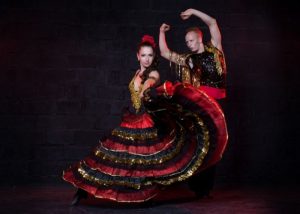 Jerez comes alive each year at the end of February, beginning of March with the colour and sounds that only flamenco can bring. Moreover, singing, dancing, and guitar music are on every street corner, and plaza around Jerez. There is a unique atmosphere in the town.
Jerez comes alive each year at the end of February, beginning of March with the colour and sounds that only flamenco can bring. Moreover, singing, dancing, and guitar music are on every street corner, and plaza around Jerez. There is a unique atmosphere in the town.
The golden triangle of flamenco music is located within the city walls of Jerez de la Frontera, Cadiz, and the Triana district of Seville.
People come from all over the world to take part in this Flamenco Festival.
March
Las Fallas, Valencia
 This unique event normally takes place in March each year. However, due to Covid restrictions over the last year and a half, the event was postponed and only took place in September 2021.
This unique event normally takes place in March each year. However, due to Covid restrictions over the last year and a half, the event was postponed and only took place in September 2021.
But, in mid-March 2022, it is hoped will Valencia light up its streets for an entire week of celebration and parties. The whole city gets involved as giant paper Mache figures representing famous characters are created. These are then displayed in the city during the full week of the celebration before being thrown onto bonfires. Every year a winner for the best creation is chosen. Sometimes it can take an entire year to create these fallas.
The sardine festival
This is quite a strange festival which takes place after the carnivals have finished. Its true origins are not known, although, as with many traditions in Spain, there are also many theories. However, the tradition is captured by Goya in one of his paintings. The actual burial of the sardine is a ceremony.
One such theory states that in the 18th century King Carlos III was given some sardines that turned out to be rotten, he immediately ordered them to be buried.
However, mainly, the ceremony is used is to mark the beginning of lent after the celebrations of the Carnivals have ended.
The locals dress up in black, some as priests and some as nuns. They carry the sardines through the town for everyone to see in something like a funeral procession which ends up at a bonfire. Here a symbolic sardine is burned.
This is said to drive away evil and negative thoughts with the ashes representing happiness, peace, and harmony. When the sardines are buried, it is said to purge the past and allow society to be reborn and transformed with new energy and life.
Festival de Cine Málaga
This takes place from March 18-27 and celebrates its 25th anniversary. The festival presents its best documentaries and short films. And helps promote the development of Spanish language films. It is an event for every audience.
April
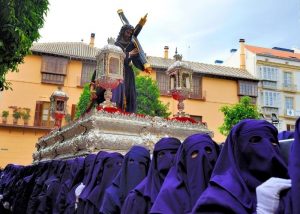 Semana Santa
Semana Santa
Semana Santa, (Holy Week) celebrates Easter and is from Sunday, April 10 – 17. It is the most important celebration in Spain.
During this week, thousands of people take part in processions as massive floats are brought to the church. These floats are huge, intricate, and elaborate pieces of artwork, and feature statues of the Virgin Mary, Jesus on the cross and show important events such as The Last Supper. Those carrying the floats can look quite sinister and intimidating as they wear mainly white or purple silky costumes with pointed hoods, covering their heads and faces. Following the floats are the mourners of the death of Jesus. They are mainly dressed in black and wearing veils. Furthermore, the processions take hours but are not to be missed. At home Spaniards serve traditional Easter food, like ‘torrijas’, ‘buñuelos’, ‘roscos fritos’ and ‘bartolillos’.
Día de San Jordi, Catalonia

This romantic day takes place on April 23. It is a day filled with roses, books, and lovers. Throughout Catalonia, World Book Day becomes an especially romantic festivity. It is also the day they celebrate their patron saint, Sant Jordi. The day is like Valentine´s day as we know it, but it is tradition for the men to be given a book and the women to be given a rose. It is an amazing sight, and you will see lots of pop-up book and flower stalls. The romance can be felt everywhere.
Feria de Abril – Sevilla
Probably one of the biggest and most important of the April festivals in Spain is the Seville April Fair. The festival is held during Easter week; therefore, the actual festival dates vary each year. So, it is always best to check before booking your holiday. For example, this year, it begins on Sunday, May 1 at zero hours and ends on Saturday, May 7 at midnight. However, the “fish dinner” prior to the opening of the Fair is on Saturday, April 30.
Although the feria is in Sevilla, people come from all over Andalucia. Stunning Flamenco dresses are worn, and the men on horseback wear the traditional “traje de corto”. There are horses and carriages everywhere. The atmosphere is like nothing else you will have experienced.
May
Battle of the flowers
On the first or second day of May, the battle of the flowers in Cordoba begins. This is a colourful sight and is to welcome the start of spring. Floats covered in flowers parade with those on-board throwing carnations to the watching crowds. The crowds then throw the flowers back – thus the name.
Feria de Caballo – Jerez
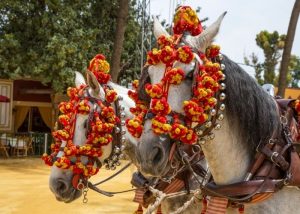
The Jerez horse fair dates back some 500 years and is an amazing spectacle whether you are a horse lover or not. The original fairs were organised by gypsies that would come to Jerez to make money by entertaining with their performing horses.
However, it was in 1955 when the Domecq Sherry family initiated the idea of a festival as a celebration to recognise the importance of the horse in the city. They are simply stunning examples.
The event includes parades, street parties, all-night singing, and dancing. Nowadays, thousands of people from all over the world attend.
The dates do change each year so always best to check before planning your trip. This year, however, it is planned for May 7 – 14.
Cordoba Patios festival
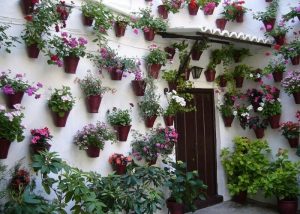 The locals of Cordoba open their colourful courtyards and patios to visitors from May 3 – 15.
The locals of Cordoba open their colourful courtyards and patios to visitors from May 3 – 15.
The patios and courtyards can be found all around the city. Although the main areas to visit are the Alcázar Viejo district, between the Alcázar and the parish of San Basilio. They can also be seen in the Santa Maria districts close to the Church of San Lorenzo. La Magdalena, the Mosque-Cathedral, and the old Jewish quarter. One of the most beautiful courtyards of all is to be found in the Palace of Viana.
Since 1921, the town hall has organised competitions for the best courtyards.
June
El Rocío pilgrimage
The famous Romeria de Rocio is held on June 5 and 6 this year. But the pilgrimage begins some days before. The pilgrimage to the village of Rocio is very traditional, and quite a spectacular event. It is one of the largest religious festivals in Andalucia. Hundreds of brotherhoods from surrounding villages and from all over Andalucia take part.
Brightly decorated horse and carts take the pilgrims on their journey. The pilgrims dress in traditional gyspy style flamenco dresses and the men in their “traje de corto” (short jackets and wide-brimmed bolero hats).
As El Rocio is built on sand, there are no proper roads. Therefore, during this time, parking areas have been replaced with fences to tie up the horses.
El Rocio it is a beautiful village and quite a unique place to visit.
Gay Pride Sitges
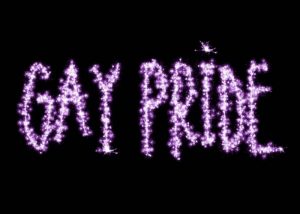 Sitges in Catalonia is home to this massive gay pride event normally held in February. However, due to Covid restrictions, it was cancelled in 2020 and 2021. This year, it will take place from June 8th – 12th.
Sitges in Catalonia is home to this massive gay pride event normally held in February. However, due to Covid restrictions, it was cancelled in 2020 and 2021. This year, it will take place from June 8th – 12th.
It is one of the most flamboyant in Spain featuring an enormous feast of local food and, of course, lots of wild parties, night shows and tribute acts.
Also, there is a fantastic drag queen parade that works its way through the town. The parades take place on the final day.
Gay Pride Sitges is listed as one of the 5 best Pride events in the world according to CNN and Lonely Planet reports.
San Juan
The Festival Noche de San Juan is one of the best June festivals in Spain, especially if you love beach parties. The celebrations begin at sunset on June 23. It is the eve of celebration before the Feast Day of Saint John the Baptist and a few days after the summer solstice.
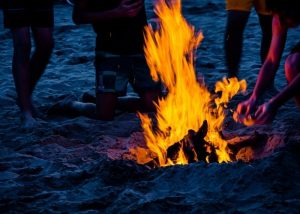 This ancient pagan festival is legendary as people believe on this night; the pagan gods are closer to humans. This night is like how we think of New Year’s Eve in as much as the day after is for new beginnings.
This ancient pagan festival is legendary as people believe on this night; the pagan gods are closer to humans. This night is like how we think of New Year’s Eve in as much as the day after is for new beginnings.
The night is all about fire and water, where everyone gathers to build fires and enjoy the night. According to tradition to be cleansed and purified, at midnight, you must jump over the fire three times and burn a list of things you wish to say goodbye to. Or you can walk back into the sea, jump the waves three times and let go of a list of wishes for the future. The sea will cleanse you and take your wishes. Alternatively, you can just wash your face in the sea.
Every area has slightly different traditions and beliefs.
Madrid pride festival
The Madrid pride festival is the biggest in Europe and one of the largest in the world for the LGBTQ+ community. The event attracts over 2 million people between June 25 and July 3. The event is packed full of parties, parades, activities, and all kinds of entertainment. It is designed to celebrate love and diversity and has visitors of all ages, races, genders, and sexual preferences
July
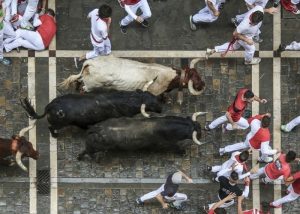 San Fermin – Pamplona
San Fermin – Pamplona
Eight days of fun, where every day, bulls chase a pack of locals and visitors along the streets of the city leading up to the Pamplona bull ring.
The Pamplona running with the bulls festival now ranks among the best-known festivals in Spain. Furthermore, it is attended by visitors from all over the world. This year´s event is from July 6 – 14.
If you are very brave, you can run with the bulls, or if not quite so brave, you can always view from the sides of the narrow streets. For those that prefer total safety, there are many that will rent their balconies to give you a good view from above.
Cider festival
The region of Asturias in Northern Spain is not only known for its beauty and greenery, but it is also the home of Cider.
One of the best cider festivals is held in the town of Nava during the second week of July.
It is a fantastic party atmosphere where you can enjoy folk music, dance, bagpipes, and live music into the wee small hours.
This is a perfect place to learn everything there is to know about Cider. There is also a contest to find the best pourers. Also, this is great fun to watch.
Virgen del Carmen
This event takes place in the coastal towns of Spain on July 16. Virgen del Carmen is known as ‘Estrella del Mar’, (the star of the sea). She is of particular importance to Catholic mariners who prayed for her protection. La Virgen del Carmen is the patron saint of fishermen and sailors. It is a day for the virgin to bless sailors and fishermen and to honour those who have lost their lives at sea.
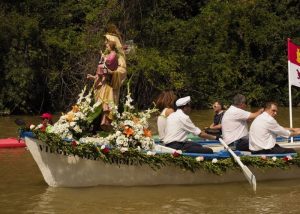 According to legends, the Virgin del Carmen is responsible for keeping the waters around the shore clean and safe. As such, many devotees refuse to swim until after July 16th!
According to legends, the Virgin del Carmen is responsible for keeping the waters around the shore clean and safe. As such, many devotees refuse to swim until after July 16th!
Most of the Día de la Virgen del Carmen traditions involve a parade through the town, en route to the seafront. Usually, a flower-strewn effigy of the Virgin is carried through the streets by a group of local fishermen. When they reach the sea, they are usually met by a flotilla of illuminated and decorated boats, all sounding their horns. After prayers are made for all those at sea, the statue is then customarily taken on a boat. It sails around the local harbour as the fireworks and bands accompany her journey.
August
Assumption Day
This festival is not unique to Spain as it is celebrated throughout the world. It is held on the 15th of August and is a national holiday in Spain. Several towns will hold colourful processions and firework displays for the Assumption of the Blessed Virgin Mary. It is a feast day.
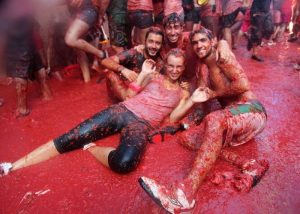 La Tomatina
La Tomatina
This event has been going since at least 1944. And each it gets bigger and better. It is celebrated on the last Wednesday of August. Therefore, the event this year takes place on the 31st
Buñol in Valencia is home to La Tomatina the famous tomato festival.
Thousands of people make their way to the small village of Buñol to battle it out in the world’s largest food fight. From the moment the cannon fires, the battle begins, and tons of tomatoes are thrown for around half an hour. This is followed by music and dancing; and most likely removing tomato debris.
Over a hundred tons of tomatoes are thrown in this unique, fun street battle.
Malaga Feria
One of the largest festivals in Spain is the Feria de Malaga which lasts for one week. The last two years have been cancelled due to Covid restrictions. However, this year is hoped to take place from August 13 – 20.
The feria features music, shows, dancing, horses, fireworks, and daily processions through the city centre. By night, the feria takes centre stage in the Real del Cortijo de Torres.
September
San Sebastian Film Festival
2022 marks the 70th edition of this famous film festival. And many actors owe their success in film to this event which was established in 1953. The San Sebastian film festival is by its own right one of the most important film cinematic celebrations of the year.
The date has yet to be confirmed but is expected to take place from September 16 – 24.
Since its inception, some of the most iconic actors have graced the festival including Sigourney Weaver, Antonia Banderas, Dame Judi Dench, Penelope Cruz, Ewan McGregor, Johnny Depp and many more.
It is a top-notch film festival and well worth checking out if you plan to visit the Basque country in September.
Rioja wine harvest festival
Logroño is the capital of the world-renowned wine region of La Rioja in northern Spain. And each year they celebrate the grape harvest.
The Rioja wine festival is held around September 21 and celebrates the feast of San Mateo of Logroño. The Festival originated in the 12th century and over time grew in popularity by attracting merchants from all over Spain.
The grapes carried by hundreds of children from local vineyards are poured into wine barrels. Then they are transferred into large wooden tubs and pressed by bare-foot men wearing traditional clothing. The first jug filled is offered to the statue of the Virgin de la Valvanera (the patron of La Rioja).
As you would expect, the festival involves lots of food, drink, dancing and singing.
La Merce festival
September is the beginning of the closing parties, and La Merce festival is one of the most famous.
This is a street festival in Barcelona that takes place from September 21 – 25 and includes numerous live concerts, parades, fireworks. It is also famous human towers (Castellers).
Dating back to 1871, the event is held in honour of Mare de Deu de la Merce (patron saint of Barcelona). The event is a farewell to summer and a welcoming to autumn
Thousands of people gather to watch the Castellers (human towers) take place at the Placa de Jaume.
October
Human tower festival, Tarragona
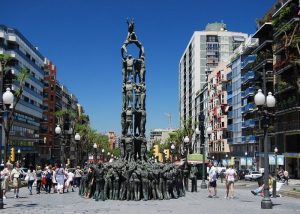
Like the famous Merce festival held during September in Barcelona, the human tower festival held in Tarragona is held in either June or October and is visited by thousands every year. In even-numbered years, the event takes place in October.
The towers are formed by teams that practice throughout the year and can reach up to 10 stories in height. Once built the participants must dismantle the tower without falling.
The unique tradition of building human towers “Castells” makes for an unforgettable experience.
Spanish National Day
This is Spain’s national holiday and is celebrated on October 12 each year. During this ‘Día de la Hispanidad‘, Spaniards commemorate the first time that Christopher Columbus sailed for the Americas.
There is an armed forces parade held in Madrid which usually includes members of the Spanish royal family plus a wide range of foreign dignitaries are also usually in attendance.
Other Spanish national holidays.
November
All Saint´s Day
November 1 is an important national holiday in Spain and allows people to reflect on life and remember family and friends who have passed on.
In the morning, there are masses at local cemeteries and churches. But after the remembrance part has finished, it is a day to celebrate the dead.
International Sherry week
The Jerez Wine Festival is an excellent excuse to get to know everything about Sherry.
During International Sherry Week there are plenty of opportunities for wine tasting sessions and pairing events. There are also visits to vineyards for the day and learning how Sherry is made. Also, there are masterclasses and cooking experiences.
A real experience for the enthusiasts, and a fantastic introduction to the novice.
December
Día de la Constitución
This Spanish holiday is celebrated on December 6th and marks the approval of the Spanish Constitution by the Spanish people in 1978. It follows the death of the dictator Franco in 1975 and therefore, the transition to democracy.
Día de la Inmaculada Concepción
December 8 is the day of Immaculate Conception of Mary (La Inmaculada Concepción de la Virgen María)
Often, the day between December 6 and 8 is taken as a holiday. And for those who live in the campo, it is traditional in these villages for the Matanza. This is the slaughtering of a pig.
Christmas
December 25 is not traditionally celebrated here in Spain, however as more and more foreigners integrate, it is an excellent excuse for an extra celebration
 New Year’s Eve
New Year’s Eve
The end of the year. Typically, most Brits when celebrating the new year here, have two opportunities to ring in the new year due to the one-hour time difference between the UK and Spain.
Editors notes
Due to ongoing Covid restrictions and changes, it is advised to check out the tourist information sites before confirming a visit. The official Spanish tourist website can be found here.
*The Three Kings Procession may be a static event instead, and therefore, you may have to book. Please check in your local area.


